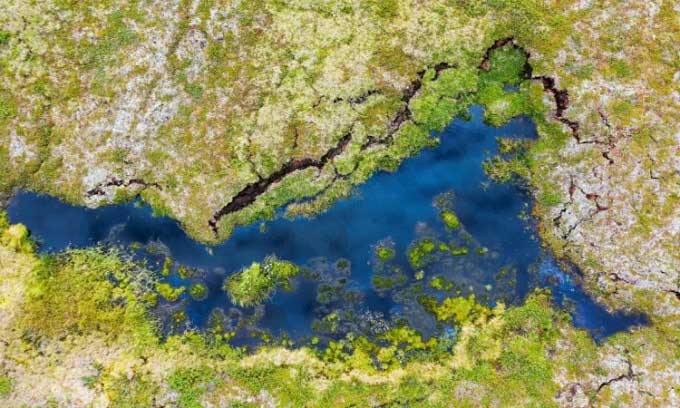The 'time bomb' beneath the permafrost
Permafrost melting due to global warming brings with it many threats such as the release of greenhouse gases, fractured infrastructure and changing landscapes.
Nestled beneath the snow-capped mountains, the Stordalen Plateau peat swamp is dotted with puddles of all sizes. The smell of rotten eggs wafted through the air. In the Arctic at the extreme north of Sweden, about 10 kilometers east of the small town of Abisko, warming is happening three times faster than elsewhere in the world. In this silty patch of grass and shrubbery, researchers are studying the deformation of permafrost soils.
As Keith Larson walked through the experiments, the boardwalks laid across the land sank into the marshes and muddy ponds below, and tiny bubbles appeared. The characteristic odor emanating from the ground comes from hydrogen sulfide, sometimes called marsh gas. But what worries scientists is another gas that comes with it, methane . Carbon stored inside permafrost soil is leaking.

The frozen soil melts causing the polar ground to appear many cracks. (Photo: AFP)
Permafrost contains about 1.7 trillion tons of organic carbon, nearly twice the amount of carbon in the atmosphere. Methane exists only 12 years in the atmosphere than CO 2 saved for decades but this powerful greenhouse gas 25 times, given the cycle of 100 years. Researchers warn that permafrost is a "time bomb" that releases carbon.
In the 1970s, when researchers began studying polar permafrost, mud ponds had not yet appeared, according to Larson, project coordinator at the Center for Climate Impact Research at the University of California. University of Umea, located at the Abisko Scientific Research Station. The smell of hydrogen sulfide mixed with leaking methane did not spread as far as it does today.
Permafrost is the name for land that is frozen year-round for at least two consecutive years, located in the Northern Hemisphere. In Abisko, the permafrost beneath the marsh can be tens of meters thick, dating back thousands of years. In many parts of Siberia, this soil layer can be more than a kilometer deep and hundreds of thousands of years old. With average temperatures rising in the Arctic, the permafrost begins to melt. In the process, bacteria in the soil break down the biomass stored inside. The process releases greenhouse gases like carbon dioxide and methane, which contribute to accelerating the rate of climate change.
In the much smaller Storflaket Swamp a few hours' drive away, researcher Margareta Johansson in the Department of Geosciences and Ecological Sciences at Lund University has been tracking melting permafrost since 2008 by measuring the meltwater. in the summer. By 2100, permafrost could melt dramatically if CO2 emissions do not decline, say ocean and glaciologists at the United Nations Intergovernmental Panel on Climate Change (IPCC). National (UN) warning. The average annual temperature of the Arctic increased by 3.1 degrees Celsius from 1971 to 2019, compared with 1 degree Celsius worldwide.
Permafrost soils can reach a tipping point when temperatures rise to a threshold that alters ecosystems and threatens global systems. For example, researchers fear the Amazon rainforest could transform into tall grasslands or the ice sheets above Greenland and West Africa melt completely.
"If all the frozen carbon were released, the carbon concentration in the atmosphere would increase almost threefold," said Gustaf Hugelius, an expert on the carbon cycle of permafrost at Stockholm University. " But that will never happen. The melting of the frozen soil will not happen at the same time."
Instead, the carbon will leak out for decades, even hundreds of years. The big problem with permafrost is that melting and the accompanying release of carbon will continue even as humans cut emissions.
In Abisko, a small lakeside town, visible signs of thawing permafrost are cracks in the ground and phone booths tilting as the ground moves. In Alaska, where permafrost accounts for 85% of the time, melting causes the pavement to deform. Houses in cities in Siberia are cracked. Yakutsk, the world's largest city built on permafrost, even had to demolish some badly damaged structures. The melting of frozen soil also affects water pipes, sewer pipes and oil pipes.
Across the Arctic, permafrost could impact about two-thirds of infrastructure by mid-century, according to a draft IPCC report. More than 1,200 residential areas, 36,000 buildings and 4 million people will suffer the consequences. The phenomenon also leads to dramatic changes in the landscape as standing water creates new ponds or opens up new watercourses causing the area to dry out completely.
- Secrets revealed under 'eternal time bomb' in Siberia
- Earth's permafrost is beginning to melt
- The permafrost of the permafrost dissolves earlier than 70 years in shock
- The most powerful thermonuclear bombs in the world
- Mysterious hot stone plate is melting Antarctica
- Discovered another source of volcanic heat in Antarctica
- The world's largest atomic bomb explosion 54 years ago
- Arctic ice lake caught fire mysteriously
- Electric waste like global time bomb
- Radiation levels increased near the place where the North tried the H bomb
- Super wallpaper ... bomb
- For a long time, you always carry a time bomb without realizing it
 Is the magnetic North Pole shift dangerous to humanity?
Is the magnetic North Pole shift dangerous to humanity? Washington legalizes the recycling of human bodies into fertilizer
Washington legalizes the recycling of human bodies into fertilizer Lightning stone - the mysterious guest
Lightning stone - the mysterious guest Stunned by the mysterious sunset, strange appearance
Stunned by the mysterious sunset, strange appearance